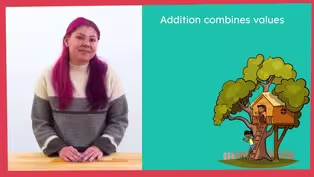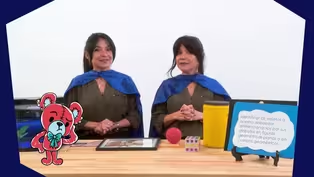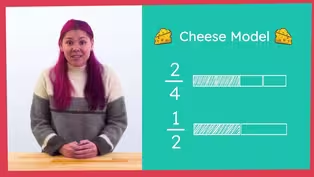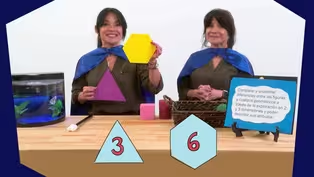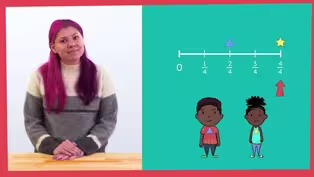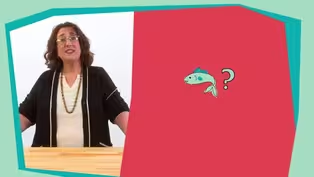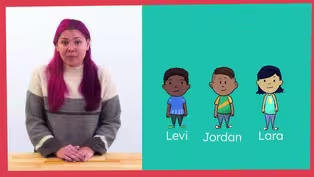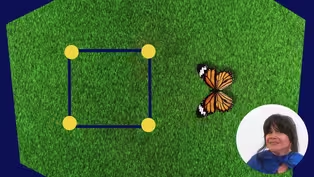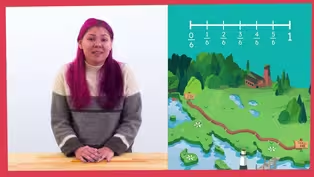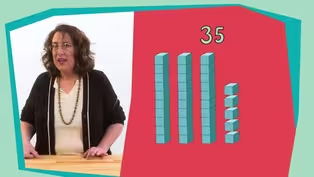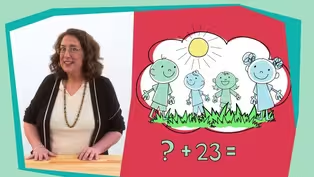
Episode 38 | Math Lessons
5/3/2021 | 28m 46sVideo has Closed Captions
Math lessons for early learners, led by NC teachers.
The first lesson (aimed at 3rd graders) teaches students multiplication and division with factors, quotients, and divisors up to and including 10. The second lesson (also aimed at 3rd graders) makes sense of multiplication using arrays and repeated addition. Classroom Connection is your At-Home Learning companion where children love to learn. All lessons are led by NC educators.
Problems playing video? | Closed Captioning Feedback
Problems playing video? | Closed Captioning Feedback
At-Home Learning Presents: Classroom Connection is a local public television program presented by PBS NC

Episode 38 | Math Lessons
5/3/2021 | 28m 46sVideo has Closed Captions
The first lesson (aimed at 3rd graders) teaches students multiplication and division with factors, quotients, and divisors up to and including 10. The second lesson (also aimed at 3rd graders) makes sense of multiplication using arrays and repeated addition. Classroom Connection is your At-Home Learning companion where children love to learn. All lessons are led by NC educators.
Problems playing video? | Closed Captioning Feedback
How to Watch At-Home Learning Presents: Classroom Connection
At-Home Learning Presents: Classroom Connection is available to stream on pbs.org and the free PBS App, available on iPhone, Apple TV, Android TV, Android smartphones, Amazon Fire TV, Amazon Fire Tablet, Roku, Samsung Smart TV, and Vizio.
Providing Support for PBS.org
Learn Moreabout PBS online sponsorshipMore from This Collection
Math lessons for early learners, led by NC teachers.
Video has Closed Captions
Math lessons for early learners, led by NC teachers. (28m 46s)
Video has Closed Captions
Math lessons for early learners, led by NC teachers. (28m 46s)
Video has Closed Captions
Math lessons for early learners, led by NC teachers. (28m 46s)
Video has Closed Captions
Math lessons for early learners, led by NC teachers. (28m 46s)
Video has Closed Captions
Math lessons for early learners, led by NC teachers. (28m 46s)
Video has Closed Captions
Math lessons for early learners, led by NC teachers. (28m 46s)
Video has Closed Captions
Math lessons for early learners, led by NC teachers. (28m 46s)
Video has Closed Captions
Math lessons for early learners, led by NC teachers. (28m 46s)
Video has Closed Captions
Math lessons for early learners, led by NC teachers. (28m 45s)
Video has Closed Captions
Math lessons for early learners, led by NC teachers. (28m 46s)
Video has Closed Captions
Math lessons for early learners, led by NC teachers. (28m 45s)
Video has Closed Captions
Math lessons for early learners, led by NC teachers. (28m 46s)
Providing Support for PBS.org
Learn Moreabout PBS online sponsorship[cheerful upbeat music] ♪ - Wow.
Did you know there are 86,400 seconds in a day?
How do we know this?
Math!
Thanks for spending 1,800 of them with us.
Here's today's math lesson.
- Hi, mathematicians!
It's me, Ms. Altman, and it's amazing to see you.
I am so excited about showing you a new math strategy today where we will use the factors that we know to solve a problem.
Before we get started, let's take 20 seconds to grab some supplies that we will need for our time together today.
You will need paper and a pencil.
I'm going to go and get mine.
Why don't you go ahead and do the same?
See you in a little bit!
[gentle music] Oh my goodness!
Can you believe that I have to complete inventory of all of these cans?
Can you help me with the inventory?
[bright music] Oh, that's a great question!
What is inventory?
Inventory means to make an organized list of items.
It tells you how many and the type of items that you have.
In this case, I have to complete inventory of the canned goods.
[groans] I'm gonna be here all day.
There's vegetables, fruit, and even soup in cans.
Do you think we could use a math strategy to help us inventory all of these cans?
What's that?
Multiplication might help us with inventory?
That's an extraordinary idea!
Today we're going to learn a new multiplication strategy where we will use known facts to help us solve multiplication problems.
This strategy is similar to breaking apart or decomposing a factor.
You may have learned this strategy in school.
If you didn't learn the strategy in school, no worries.
I have a video of the strategy on the PBS NC YouTube channel.
Just ask a trusted adult for permission to get on the internet so you can view that video.
Using known facts means that we can use the multiplication facts that we immediately know to help us solve facts that we don't know yet.
Think of it as mental math where we don't have to draw pictures or make arrays because we know the facts [snaps] just like that and we can use them to help us solve the ones we don't know yet.
For example, a little birdie told me that you know all of your fives multiplication facts.
Since I know my fives multiplication facts, just like [snaps] that, I can use them to help me with other multiplication facts that I don't know yet.
Let's review the fives multiplication facts together.
I will say the factor and I want you to say the product with me.
As I say the factors, you will see an array on the screen.
1 times 5 equals?
5.
2 times 5 equals?
10.
3 times five equals?
15.
Great job, mathematicians.
Keep saying those products with me.
4 times 5 equals?
20.
5 times 5 equals?
25.
6 times 5 equals?
30.
7 times 5 equals?
35.
8 times 5 equals?
40.
9 times 5 equals?
45.
And 10 times 5 equals?
50.
Now that we have reviewed our fives multiplication facts, let's use the facts that we know, like our five facts or other factors that we immediately know, to help us solve multiplication problems.
Are you ready?
Great!
Let's get started.
Take a look at these cans.
My supply list says that I have seven types of canned soups, and there are nine kinds of each type.
Mm, that's a lot of delicious soup.
I can think of this as having seven groups with nine cans in each group, or 7 times 9.
How can I solve this problem?
What is 7 times 9?
Yes, we could draw pictures of equal groups or build an array, but is there a way to solve this problem using mental math or the strategy for this lesson, using known facts?
I'm sorry, can you repeat that?
Do you mind if I share that with our other math friends?
Great!
One of our mathematicians stated they're not sure about their nine facts yet.
They are still practicing these facts and want to know if they can use a fact that they immediately know to help them solve 7 times 9.
What's that?
Oh, someone said they know their five facts and we just reviewed them.
So using our fives can help us.
That's a great idea.
Let's use our five facts that we know just like [snaps] that to help us find the product for 7 times 9.
Oh wait!
Someone had a question.
Someone asked, "How can we use our known five facts to help us think about the product of 7 times 9?"
Hmm.
Well, let's think about the different ways that we can break apart the factor nine and see if using the facts that we know, in this case, the five facts, can help us solve 7 times 9.
I'll give you some time to think about that.
Turn and talk to a friend or trusted adult.
What are all the different ways that we can break apart the factor nine?
[gentle guitar music] That's right!
We can break apart the factor nine into 8 plus 1, 7 plus 2, 6 plus 3, 4 plus 5, and so on.
Wow, that is a lot of ways to break apart the factor of nine.
Which way should we pick?
That is, which way should we break apart the nine factor so we can solve 7 times 9 and use our five facts to help us?
Yes, we can break apart the 9 into 4 and 5.
That will help us use our known five facts to solve the problem.
Let's rewrite 7 times 9 as 7 times 5 plus 7 times 4.
Okay, now that we talked about that, let's continue thinking through this problem.
I know that 7 times 5 is the same as 35, and I know that 7 times 4 is the same as 28.
Now I can add the product of 7 times 5, which is 35, and 7 times 4, which is 28, together to answer our problem of 7 times 9, which is 63.
Great job, everyone.
As we transition over to our next problem, I would like to invite you to stand up or sit up tall.
We're gonna take a quick movement break that I like to call Take 5.
You can either take five hops, five stomps, [feet stomps] five claps, [hand claps] five stretches, or five freestyles.
[fingers snap] I'm gonna take five claps.
- One, [claps] two, [claps] three, [claps] four, [claps] five.
[claps] Now it's your turn.
One, two, three, four, five.
Great job!
Let's try another problem and see if we can use a known fact to help us out.
How about 6 times 8?
Are there any facts that you know that can help us solve 6 times 8?
Oh, great idea.
We just decomposed 9 into 4 and 5, so you want to use fours facts to help us solve 6 times 8.
Let's review the fours multiplication facts.
I will say the factors and I want you to say the product with me.
As I say the facts, you will see an array on the screen.
1 times 4 equals?
4.
2 times 4 equals?
8.
3 times 4 equals?
12.
4 times 4 equals?
16.
5 times 4 equals?
20.
6 times 4 equals?
24.
7 times 4 equals?
28.
8 times 4 equals?
32.
9 times 4 equals?
36.
And 10 times 4 equals?
40.
So let's use our four facts now that we know them just like [snaps] that to help us think about the product of 6 times 8.
Wait, I'm confused.
Help me remember, why can we use our known facts to help us think about the product of 6 times 8?
Let's think about different ways that we can break apart the factor 8 this time, and see if using our known four facts is an option.
Turn and talk to a friend or a trusted adult.
What are all the different ways that we can break apart the factor eight?
[upbeat music] That's right.
We can break apart the factor eight into 7 plus 1, 6 plus 2, 5 plus 3, 4 plus 4, and so on.
Which way should we pick?
That is, which way should we break apart the eight factor so we can solve 6 times 8 and use our fours facts?
Yes, we can break apart the 8 into 4 plus 4.
That will help us use our known fours facts to solve the problem.
Let's rewrite 6 times 8 as 6 times 4 plus 6 times 4.
What's that?
Awesome!
You know that 6 times 4 equals 24.
And we also know that we need another group of 6 times 4, which is again, equal to 24.
What's that?
Great.
Well, kiss your brain and blow it out of this world.
[lips smacking] Pow.
You knew ahead of time that 6 times 8 is the same as having two groups of 6 times 4.
That is awesome.
Now I can add the products of 6 times 4, which is 24, and 6 times 4, which is 24 again, together to answer our problem of 6 times 8, which is 48.
Great job, everyone.
[hands clapping] Wait.
What's that?
You used another known fact to solve the problem and you wanna share what you did?
Awesome!
I'll share your strategy with everyone.
Someone said that they already knew 6 times 7 was the same value as 42.
And then they just added another group of six.
Do you know why our friend added another group of six?
That's right.
They multiplied six groups of seven to get 42 so they needed one more group of six to make eight groups of six, or 48.
So let's look again, friends.
One friend made two groups of 6 times 4 using the facts that they know.
Another friend used the facts that they know, 6 times 7 equals 42, and added 6 times 1, using the facts that they know.
Both strategies are correct, and they were much easier for our friends because they were able to use the facts that they know to figure out the ones they didn't know yet.
Thanks for joining me today.
I hope you had fun learning a new strategy of using known facts to solve multiplication problems.
It's similar to breaking apart a factor.
But instead of breaking the problem into smaller numbers, you purposely break the problem into facts that you know.
Join me next time to learn more math strategies.
Bye, mathematicians!
[gentle music] [chill music] - One thing that really makes me happy during tough times is counting on my community.
Are there people in your community that help you?
I cannot wait to share this next video with you about the folks in our community doing good.
- My name is Tyler.
I am 17 years old.
My girl power is using my love of science to make an impact through cancer research.
[upbeat music] ♪ Beautiful ♪ ♪ You're beautiful ♪ ♪ Crazy kind of beautiful ♪ [gentle piano music] It is very empowering for me to wanna be in the field of science.
There's a drive in me that says, "Women fought for you to be able to go do this.
You have the capability.
You should step up and go into this field because you know that you'll do good in it."
I decided to pursue a career in cancer research, mostly because I lost all four of my grandparents to cancer in the course of two years.
I'm good at science.
This is something that I can help with.
And I think, seeing that my grandparents, they got to live out their life really impacted me to say, "You know what?
I wanna take my love of science and put it towards saving children with cancer so that they may have the life my grandparents at least got to live."
I was one of the top 100 students selected out of 1000 students across the US to receive the Emperor of Science Award.
I was paired with a mentoring scientist at Wake Forest Baptist Cancer Center to perform stem cell research.
[upbeat music] During the summer, I participated in a program called VolunTEEN, where high school students get the opportunity to volunteer at our local hospital, Mission Hospital McDowell.
My role was working in infusion with the cancer patients.
Hello, Miss Nancy.
Can I offer you any company?
Are you okay?
- Yes, that would be fine.
- It's hard to be hooked up to an IV and chemo all day.
I would go in and just talk to them if they didn't have a relative with them or I would bring their lunch to them.
And sometimes even run samples down to the lab.
Hey, here's the sample from 203.
- Okay.
- Thank you.
Another one of my girl powers is coaching Special Olympics soccer and swim.
Working with others and getting to go do these activities and all these different things that I'm involved in gives me my high to live.
Set, go.
I honestly feel like I feed off of other people's energy.
And so being able to go coach swim, that's it, or to go volunteer at the hospital- - It's nice to have company.
- It gives me fuel for the day.
It gives me a reason to wake up.
Just the little things of getting to see an elderly person getting chemo treatment smile because I brought them their favorite treat or seeing the different kids give me a high five because they're so excited that they accomplished something.
Those types of things make you realize whether or not you see it, you're making a difference in their lives, little by little, and that kind of just brings me so much joy.
I literally will come home with a smile on my face all afternoon after going to swim practice or the hospital.
Embrace your girl power.
- Today's affirmation is I am as strong as my heroes.
Now I want you to be loud with this one.
I am as strong as my heroes.
[chill music] I am as strong as my heroes.
I am as strong as my heroes.
- Did you know the average yawn lasts six seconds?
One, two, three, four, five, six.
Next time you yawn, count to see how long it lasts.
But you won't be yawning anytime soon 'cause we have a super cool math lesson for you.
This will help count down those seconds.
[chill music] - Hello, friends.
My name is Diane.
I'm so happy to see you.
Today we're going to be talking about how to represent things that come in groups.
I just got back from one of those big superstores where you can buy everything you need: groceries, clothes, school supplies, all at the same store.
Here's what I bought today.
Some juice boxes, snack cakes, cracker packs, packages of nuts, glue sticks, socks, markers, and batteries.
What do you notice about the way they are all packaged?
What was that?
Yeah.
That's right.
All of these items are packaged in groups.
[air whooshes] I made a list of some more things that come in groups.
Wanna take a look?
It's pretty cool, we've got eyes that come in pairs, so that's two.
We've got three angles on a triangle.
We've got six legs on an insect.
Got seven days in a week.
And we've got 10 fingers.
[air whooshes] This has me thinking about math problems that have equal groups.
Wanna help me solve some?
Great, thank you.
Let's start with this pair of socks.
One pair has two socks.
I can represent it with pictures, words like 1 group of 2, or with a number sentence, say 1 times 2.
What does the 1 represent?
Exactly!
The number of groups.
And what does the 2 represent?
For sure.
The number in each group.
Then let's look at that symbol in the middle.
What does that represent?
You whisper it to me.
[gentle music] Yeah, the multiplication equation.
We can represent equal group problems with a multiplication symbol.
So, let's think about it.
What if we had two pairs of socks?
How would we represent that?
We could say 2 groups of 2 or 2 times 2.
How can I find the total total number of socks?
Yeah, I can count by twos.
We've got two, four.
Now, what about four pairs of socks?
Exactly, we could have 4 groups of 2 or 4 times 2.
So how many altogether?
Count with me.
Two, four, six, eight.
Now, how about six pairs of socks?
You got it.
6 groups of 2 or 6 times 2.
So how many altogether?
One more time, count with me.
Two, four, six, eight, 10, 12.
Oh, I said one more time, but we got another one, here we go.
What about 10 pairs of socks?
Yep, 10 groups of 2 or 10 times 2.
Try this one on your own.
What did you get?
What was that?
Great job, yes.
10 times 2 does equal 20.
Hmm, I wonder what else we could count in groups.
Hmm.
[snaps] Oh, these juice boxes are packaged in groups of 10.
How many groups of boxes do we have?
Yes, exactly.
We have two groups of juice boxes.
So how many are in each group?
Yes.
There are 10 juice boxes in each group.
How can we figure out how many total juice boxes we have here?
Hmm.
We could count by ones, but that might take a while.
Do you think that there's a better way?
Oh, oh, I heard someone saying count by tens.
That's a great idea.
Let's try that out.
So count by tens with me.
10 juice boxes, 20 juice boxes.
Excellent.
There are 20 juice boxes.
Now, let's think about how could we represent our counting.
I'll give you a moment to think.
Right!
We could write two groups of 10 or 2 times 10.
What does the number 2 represent?
Say it with me, folks.
Right, the number of groups.
What about the number 10?
Exactly, the number of juice boxes in each group.
And what about the 20?
Yes, we have 20 juice boxes altogether.
So now what if I had three groups of juice boxes?
3 times 10 equals?
Count with me.
10, 20, 30.
What about four groups of 10?
10, 20, 30, 40.
What about six groups of 10?
10, 20, 30, 40, 50, 60.
[fingers tapping] All right, here we go.
10 groups of 10.
10, 20, 30, 40, 50, 60, 70, 80, 90, 100.
If we were to count groups of batteries, what would we count by?
Yes.
Fours.
What about these box of crackers?
Yes.
Sixes.
What about the markers?
Exactly.
Tens.
What about the cupcakes?
Eights.
Awesome job, mathematicians.
Let's talk about a word that will show up during our time together.
We're going to be talking today about the word factor.
What we want to know is that when we're talking about factors, we're talking specifically about multiplication.
So, with that being said, factors, if we're defining them, are two numbers multiplied together.
[bright music] A lot of times when we're writing a number sentence, when we're talking about multiplication, you'll see blank times blank.
That looks more like a plus sign so we're gonna make sure that we know that it's multiplication.
These two blanks would be where we put our factors.
So then what do these mean?
That's a great question.
One of them is going to be talking about the number of groups.
[gentle music] That is going to be 10 packs of pencils or we're going to be talking about three packs of crackers, whatever the case may be, it's that number of groups that we have.
The second factor that we're talking about is going to be the number in each group.
When we talk about the number in each group, how many pencils were in those packs?
Was it five?
Was it 10?
Whatever the case may be.
It's however many are in the group.
The biggest thing when we're talking about factors is that we are going to be looking at equal groups.
So let's look down at my train cars.
You say, "Oh, I see three train cars.
So I've got three groups."
Now, what about the number in each group?
What do you notice here?
Right!
They're unequal.
That would be an issue if we're trying to figure out a factor because the number in each group is unequal.
So now looking at this, how are we going to make this equal?
What would you do?
I know for me, I would definitely have one of these people, where there's three in the train car, come over here to hang out with this person.
Then, I've got two people in this train car, two people in this train car, and two people in this train car.
So, my two factors for this are going to be 3 and 2.
3 train cars and 2 people.
Understanding factors is so important when you're learning about equal groups.
[air whooshes] Awesome job, mathematicians.
Thanks for helping me think about things that come in groups.
We learned that we can represent equal groups with pictures, numbers, and the multiplication symbol.
You also helped me find the total number of items with counting strategies.
Great job.
I'm going to go put up these groceries but I wonder what else I'll find that come in groups.
Maybe you could look around your house to see what comes in groups.
Join me next time to explore more multiplication strategies.
Bye, y'all.
[air whooshing] - Well, it's time to go, but I can't wait to see you next time.
Hope you learned a lot today and every day.
Wishing you peace, love, and lots of learning.
[cheerful upbeat music] ♪


- Home and How To

Hit the road in a classic car for a tour through Great Britain with two antiques experts.












Support for PBS provided by:
At-Home Learning Presents: Classroom Connection is a local public television program presented by PBS NC
